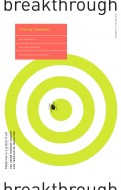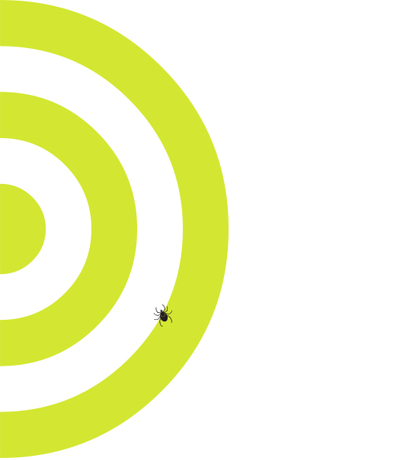

David B. Hellmann,
M.D., M.A.C.P.
In Ridley Scott’s new movie, “The Martian,” there’s a wonderful scene in which astronaut Mark Watney, stranded on Mars, chooses to overcome his situation instead of give in, and he does it through faith, sheer grit, and because he’s determined to “science” the heck out of it, to work the problem. He also manages to survive because he’s got a lot of people all over planet Earth working just as hard to meet every new and difficult challenge he must face.
This issue of Breakthrough has the same “right stuff” – to borrow from another space movie. We’ve got investigators working to science the heck out of some pretty tough problems: lung cancer, Lyme disease, and age-related illness. The science they’re doing is creative, and it’s collaborative, because these are problems that need the expertise of people in different disciplines, and it all starts and ends with our patients.
But science can’t do everything. Our motto, “Medicine is a Public Trust,” begins with patients, too, and our first job as doctors is to care, and to notice things. For instance, we have long noticed that the people in our immediate neighborhoods around Johns Hopkins Bayview and Johns Hopkins Hospital don’t live as long as the people who live in more affluent neighborhoods further out in the suburbs. In fact, people in neighborhoods like Roland Park or Ruxton live 20 years longer than people who live right here, a block or two away from us. There are three major health causes for this: heart disease, cancer, and HIV/AIDS. (Unfortunately, another major cause of death is not health-related but a symptom of a violent culture: homicide.)
We can’t help noticing it, we can’t help thinking that this isn’t right, and we believe that we are uniquely able to do something to help. The CIM’s Five and Ten Initiative proposes that Johns Hopkins Bayview and its University partners focus their efforts and resources to increase the longevity of the residents in our neighborhood by five years over the next decade. We will be talking more about this in future issues of Breakthrough, but I wanted you to know that this is in the works. For more on how and what the CIM is doing, see the story on Page 21 about our recent retreat.
Other exciting news: Our Aliki Initiative is expanding to become the CIM Good Doctor Initiative, and it is growing to include nursing students and a nurse Attending. This is a groundbreaker for medical education, and it’s long overdue. Nurses and doctors work together, and yet they learn separately – nursing students with nurses and medical students with doctors (see story on Page 12). Speaking of excellent clinicians, there’s a nice story about one of our Miller-Coulson Academy members, told by a medical student (see Page 16).
And finally, we are celebrating quitters. In the case of cigarette smoking, being a quitter is a very good thing, and a wildly creative new program, a collaboration between our Center for Behavior and Health and the Maryland Institute College of Art (MICA) is embracing the fact that for many people, it takes several attempts before they can kick the habit for good.
These are just a few of our many reasons to celebrate in this holiday season.

Aliki Perroti Professor of Medicine;
Vice Dean, Johns Hopkins Bayview Medical Center;
Chairman, Department of Medicine
Don Willett November 13th, 2015
Posted In:


Ticks are evil. Deer ticks are even worse: little dots of evil, the size of a freckle. They spread Lyme disease, and what can happen next sounds like a horror movie.
But first, the ticks: They are the minuscule vectors that transmit Lyme disease. But really what they transmit are corkscrew-shaped bacteria called spirochetes. (Their official name is Borrelia burgdorferia; the disease is also known as Lyme borreliosis.) Spirochetes are real lowlifes in the disease world; another devastating disease they cause is syphillis. Although deer get the blame for the epidemic of Lyme disease that has hit the East Coast particularly hard, they’re just a truckstop for the ticks; a place to grab a quick meal. “Deer are immune to Lyme disease, but they are an important food source for the ticks that transmit it,” says John Aucott, M.D., an infectious diseases specialist and renowned expert on Lyme Disease, and the founding physician of the Lyme Disease Clinical Research Center. No, the real source, or reservoir, for these nasty spirochetes are rodents such as the white-footed mouse.
So let’s say you’ve been bitten by a deer tick. Most likely, you never noticed it. You may not even know you’ve been bitten unless you happen to see a telltale, bullseye-shaped rash, called Erythemia migrans – which may or may not show up after the tick sucks your blood and in return gives you the gift that keeps on giving. You may not get sick right away, either. If you do, you might mistake what’s happening as the flu. With symptoms like a headache, low-grade fever and chills, fatigue, swollen glands, achiness, and a stiff neck, who could blame you? If you’re lucky, you take antibiotics, and you get better.
If you’re not lucky, you may or may not take antibiotics, you may or may not feel better, but you won’t truly be better. Instead, the disease will get worse, as the spirochetes burrow further into your body. “Lyme disease is a heck of a lot more complicated than many people realize, because it’s got a lot of variables,” says Aucott. “Like syphillis, it’s got multiple stages; so there’s early Lyme disease, the period within weeks after the tick bite. That’s primarily a skin infection with the rash. Then in the two- to six-week range, the spirochete disseminates and the illness changes forms,” as the infection moves outward from the bite; these are the flulike symptoms. “In some people, the disseminated bacteria end up in organs like the heart, or in the nervous system – so the symptoms could look like heart trouble or meningitis. It’s kind of a moving target with all these different manifestations, depending on how far the disease has progressed.”
You may not even know you’ve been bitten unless you happen to see a telltale, bullseye-shaped rash – which may or may not show up after the tick sucks your blood and in return gives you the gift that keeps on giving.
Basically, at every stage, even the rash, Lyme disease has the potential to be misdiagnosed; especially if nobody connects what’s happening to the bite of a pencil point-sized tick. “Then in the third stage, which may be six months or even years later, you can get arthritis,” says Aucott. “So you have all these seemingly disparate illnesses that don’t appear to be related, but they’re all due to the different phases of the bacteria.” Treatment varies, depending on how widely the infection has spread. “The earlier you treat it, the easier it is to treat. If you catch it early with the rash, which is what you want to do, it’s much easier to treat than if it’s already disseminated and the patient has had heart or nervous system involvement or joint problems. It gets harder and harder to treat.”
Basically, at every stage, Lyme disease has the potential to be misdiagnosed; especially if nobody connects what’s happening to the bite of a pencil point-sized tick.
But it’s still treatable. Sharon Akers, who runs the Edward St. John Foundation, a philanthropic organization that has helped support Aucott’s work since 2010, has seen many people – friends, coworkers, family members – who were misdiagnosed, whose symptoms kept getting worse, people who became discouraged and thought this nightmare would never end – find hope and get better under Aucott’s care. She recalls one young lady, whom she and Edward St. John referred to Aucott after seeing her at a crab feast, walking “like she was drunk. Her gait was horrific,” Akers recalls. “It turned out that she was also having chronic headaches and dizziness.” Aucott diagnosed the Lyme disease, figured out that the girl’s first exposure had been years earlier, and began to treat the bacteria and address the neurological impairment. “She still has a little residual damage, but now she is totally functional and back in school.”
With Lyme disease, the big question is, “is it really gone?” When symptoms improve, sometimes all the spirochetes have been killed, but not always. Instead, what’s happening may be the disease equivalent of that deceptive calm at the end of a creepy movie; just when you think it’s safe to go back in the water, it’s not. Worse, Lyme disease can seem to shape-shift, to present with a whole new constellation of symptoms.
Eight years ago, Aucott, along with Antony Rosen, M.D., head of the Division of Rheumatology, and immunologist Mark Solosky, Ph.D., officially started a clinical research program. “We decided it was the perfect opportunity to put together a classic translational research program,” says Aucott, “one that bridges patients and the laboratory.”
The focus of Aucott’s research is “this whole phenomenon we call post-treatment Lyme disease syndrome” (PTLDS). “Patients call it chronic Lyme disease, but we’ve tried to get away from that,” because it’s not entirely accurate. “It’s a distinct part of Lyme disease that happens in a subset of patients who, when treated with antibiotics, don’t fully recover their health. That’s the controversial part of Lyme disease, because it’s much harder to get a handle on.” For example, some of the key symptoms – fatigue, pain, and inability to think clearly, or other cognitive issues – are not-very-specific pegs that could fit the description of many illnesses. “Some people think it’s really nebulous,” Aucott adds, “and to some extent, they’re right. Because there is not real blood test for PTLDS. Patients know they aren’t getting better, but until there’s a blood test to confirm that you have PTLDS, it’s going to be very hard to separate those symptoms from those of other syndromes like fibromyalgia or chronic fatigue.”
Aucott and Solosky are actively looking for biomarkers – telltale molecular signs that say, “this person still has Lyme disease.” Right now, there’s a test that can show that someone has antibodies to Lyme disease, but that’s about all it shows. “The test shows exposure, and exposure is not the same as active infection,” says Aucott. “For instance, I have antibodies to chicken pox because I had it when I was a kid, but it doesn’t mean I have chicken pox today. Those antibodies have a memory, and they stay in your system for years or decades. But the presence of antibodies doesn’t mean someone is actively sick from the infection; it just means your immune system has been exposed to it sometime in the past.” Another issue: Even if the antibodies show up, it doesn’t necessarily mean that someone’s fatigue is due to Lyme disease. It could be something else. Still other issues: The antibodies can sometimes go away. “It’s not predictable what they’re going to do.” Also: “You can get it more than once, because there are different strains. You’re not protected; I’ve had patients who have gotten it two or three times.”
With Lyme disease, the big question is, “is it really gone?” When symptoms improve, what’s happening may be the disease equivalent of that deceptive calm at the end of a creepy movie; just when you think it’s safe to go back in the water, it’s not.
In highly sophisticated detective work, Aucott and Solosky are studying patients using proteomics – the study of ultra-specific proteins, which are like footprints in the blood. “What makes our study very unique is that we have the patients at the time of their initial diagnosis, when they have the rash, before they even get antibiotics,” says Aucott. “Then we follow them for seven visits,” taking blood samples each time. “So we can follow these proteomic shifts” – the trail of the footprints – “just like you would in a patient who’s having a heart attack, except our time scale isn’t a matter of hours, but many months.” The goal is to find changes over time that can lead to a test that says, “This person still has active Lyme disease,” or “the disease is not active in this person.”
The real Holy Grail, Aucott continues, “would be if we can find a pattern that identifies people who are destined not to recover completely, the people who are going to need further intervention because they’re destined to go on to PTLDS. In medicine, we like to treat people, but then we also like to repeat their test and show that they’re cured. Like in cancer, you repeat the CT scan, or in a heart attack, you repeat the EKG. But in Lyme disease, there’s nothing to repeat, nothing to show that the person has recovered.”
Still other things to think about: When someone with Lyme disease doesn’t get better, is it because the antibiotics didn’t kill every last bacteria and a few remain dormant? “That’s one hypothesis. Or maybe the infection triggered an autoimmune disease; there’s good precedent for that, as in rheumatoid arthritis. Or maybe it’s a combination of the two; maybe most of the infection is gone, but that little bit triggers an ongoing inflammation.”
Hopkins is the first academic medical center to “formally embrace the challenge of doing research on these chronically ill patients that nobody seems to understand,” Aucott states. “I’m really proud of Johns Hopkins for being willing to tackle this.”
Don Willett November 13th, 2015
Posted In:


If only we could harness the body’s immune system. Scientists have thought about this, and tried it, and been frustrated with it, and gotten discouraged, and tried some more, for decades. The idea – tapping into the body’s tremendous, sometimes terrifying ability to fight off something it recognizes as an enemy invader – is tantalizing. The power is there. Just ask anyone unfortunate enough to suffer from an autoimmune disease: when the body unleashes its strongest defensive ammunition on itself, the consequences can be devastating. But for so long, despite brilliant and creative thinking, although scientists could boost the immune system, they could not truly enlist its power to fight disease.
That was then. Now, all of a sudden, immunotherapy is living up to its promise, and the most exciting headlines feature three words: immune checkpoint inhibitors. In recent years, new drugs called checkpoint inhibitors have shown stunning success in diseases that really needed a win – particularly, melanoma, bladder cancer, and lung cancer.
Julie Brahmer, M.D., is an internationally recognized groundbreaker in the transformative field of immunotherapy for people with lung cancer. She was one of the first to study a drug called nivolumab, developed by Bristol-Myers Squibb, which showed such promise in a clinical trial that the trial was stopped two years ahead of time. Nivolumab is a PD-1 inhibitor (see below); nothing like it existed when Brahmer, director of the Thoracic Oncology Program at the Kimmel Cancer Center, started in the field of lung cancer research in 2000. “The field was wide open, ” she says. “Even when we started the first in-human trials of nivolumab in 2006, no one thought this would ever work in lung cancer. But things have changed dramatically. There’s so much more hope now.” Some of her patients who started nivolumab in a clinical trial – people who had metastatic disease and had failed other therapies, who were expected to live maybe four to six months – are still alive four years later.
“Immunotherapy marks an entirely different way of treating cancer – by targeting the immune system, not the tumor itself.”
Think about it: Lung cancer kills more people than colorectal, breast, and pancreatic cancers combined. It will kill more than 150,000 Americans this year alone. Only about 17 percent of all people diagnosed with lung cancer live more than five years (although if it’s caught early, the likelihood of living longer than five years goes up dramatically). Worldwide, it is the deadliest cancer. And yet, here lung cancer is, at the epicenter of a revolution. In December 2013, when Science magazine named cancer immunotherapy as the “breakthrough of the year,” it said, “Immunotherapy marks an entirely different way of treating cancer – by targeting the immune system, not the tumor itself. Oncologists, a grounded-in-reality bunch, say a corner has been turned and we won’t be going back.”
All of a sudden, immunotherapy is living up to its promise, and the most exciting headlines feature three words: immune checkpoint inhibitors. In recent years, new drugs called checkpoint inhibitors have shown stunning success in diseases that really needed a win – particularly, melanoma, bladder cancer, and lung cancer.
What has caused this sea change? It’s the new scientific understanding of molecules known as immune checkpoints. Normally, these checkpoints are supposed to protect the body from autoimmune attack. But in the nefarious processes of cancer, these checkpoints are hijacked – and the cancers use them to protect themselves, snatching away the firepower even as immune cells have seen a tumor, recognized it as an enemy, and are poised to destroy it.
“We have seen tumors melt away, and not come back even after we have stopped the medication.”
A brief tour of this world of immunotherapy involves a bunch of names made up of capital letters. The initials, PD, stand for Programmed Death. PD-1 controls T cells, the invading white blood cells that fend off infections and help fight cancer. PD-L1, which binds to PD1, is on the surface of tumor cells. When a tumor is being attacked by the body, it uses the PD-L1 to shield itself from the immune cells, and this is bad. The PD-L1 cells protect the cancer. Imagine a smoke detector going off, and somebody calls the fire department and says, “Don’t worry, it’s a false alarm.” The house keeps burning. Another immune checkpoint targets a molecule called CTLA-4, which shuts down the immune system, as well, by binding either to molecules on other immune cells. The beauty of checkpoint-inhibiting drugs like nivolumab – and this whole idea of “immune checkpoint blockade” – is that they break this cycle: in other words, they call the fire department back and say, “Emergency! We need you!” Nivolumab targets the pathway that lung cancer uses to put T cells in a straitjacket. When it works, it releases the T cells and lets them get back to work. “We have seen tumors melt away, and not come back even after we have stopped the medication.” Brahmer believes that nivolumab may somehow reset the immune system and keep it reset indefinitely, maybe forever.
The responses seem to be durable, but not everyone responds; the drug works in about 20 to 25 percent of patients. It may be that combining drugs – targeting PD-1 and CTLA-4 together, for example – will be more effective. Clearly, there needs to be a way of figuring out whose cancer will respond best to which immune checkpoint inhibitor. Also, nivolumab and similar checkpoint inhibitors have been tested in metastatic disease. They might be even more effective if they were given early on in lung cancer, or combined with other forms of therapy – radiation, for example, or chemotherapy. “This is the tip of the iceberg,” Brahmer says. Another issue, “because these drugs potentially will cost so much, is trying to pick out the patients who will best respond, and use that to guide therapy.”
Brahmer believes that nivolumab may somehow reset the immune system and keep it reset indefinitely, maybe forever.
Brahmer has been named one of the principal investigators on a $20 million “Dream Team,” formed by Stand Up to Cancer and the American Cancer Society with the goal of getting new therapies to lung cancer patients quickly. The team will target mutations in the KRAS gene, which are found in as many as 25 percent of people with lung cancer.
Don Willett November 13th, 2015
Posted In:


You know what inflammation is: It’s the redness that comes right after you stub your toe or skin your knee. There’s heat, maybe a little swelling – responses we’ve come to expect, the body’s reassurance that the immune system is on the case. Healing has already begun.
But there is another kind of inflammation that happens where you can’t see it – in your tissues, in organs, in the blood. It’s often subtle, and it may not have an obvious cause. Unlike the familiar, acute kind that starts with an “Ow!” this begins when the inflammatory system gets activated and the body neglects to hit the off switch.
It’s not good. This kind of low-level inflammation tends to percolate in many of us as we age. “In some older people, the pathways that normally would fight off infection are activated,” says geriatrician Jeremy Walston, M.D., who co-directs the Biology of Healthy Aging Program. “These pathways get turned on and they just stay on.” This inflammation creates an unhealthy environment in the body, leaving us more frail and vulnerable to illness: “We think that, over time, activation of the inflammatory system makes muscles degenerate quicker, causes some level of cognitive impairment, and probably worsens most chronic disease states.”
“In some older people, the pathways that normally would fight off infection are activated.”
It’s like white noise – a quiet racket that’s always there, not unlike the dull roar of an airplane’s engines. You get used to it after a while; but people who spend many hours flying can have incremental hearing damage. Similarly, with inflammation, the body is always under a little extra stress. But could the opposite be true, as well? Could suppressing this inflammation prevent the frailty that is often associated with growing older?
Walston’s research suggests the answer is yes. In lab investigations, he and colleagues have been looking for clear molecular signals of chronic inflammation, and they have found two. Both are inflammatory mediators that can be detected on a simple blood test: IL-6 and TNF alpha receptor 1. “These are factors that get put into the circulation from inflamed parts of the body,” and they show up in the blood even if there is no outward evidence that anything is wrong, Walston says. “We don’t always know where those signals are coming from, but we believe that reducing those signals may improve function and cognition in older adults.”
“We think that, over time, activation of the inflammatory system makes muscles degenerate quicker, causes some level of cognitive impairment, and probably worsens most chronic disease states.”
The blood test he has developed would identify people with chronic inflammation; now, how to block the inflammation signals? Walston has been studying a number of drugs and has focused on two very different medications, both readily available, that seem especially promising in reducing inflammation. One of them is a drug that lowers blood pressure; the other is a milk-based protein, available as a dietary supplement, that is both an antioxidant and anti-inflammatory agent. With a three-year discovery grant from Charles H. Salisbury, Jr., a member of the CIM’s International Advisory Board, Walston is testing these drugs for a new role as a means of intervention against chronic inflammation, in a small clinical study of people age 65 and older.
In an article recently published in Journals of Gerontology: Medical Sciences, Walston and colleagues reported that 15 percent of older Americans living at home or in assisted living residences are frail – more vulnerable to chronic disease, falling or becoming disabled – but another 45 percent are considered “pre-frail,” at risk of becoming frail.
It is these people, headed toward frailty, whom Walston believes can be helped most by an inflammation-fighting intervention. “People who are robust probably don’t need it,” he says. “For people who are already very frail, it may not help.” But in lab research, he has shown for mice that “are just heading into frailty, that treatment appears to have a good impact,” preventing and even reversing some signs of pre-frailty.
This research is still in its early stages, and Walston doesn’t yet know which drug’s approach toward inflammation is better; each affects a different pathway. He is testing these drugs in a small clinical study in older adults with chronic inflammation. If these studies prove successful, he will develop a much larger clinical trial to see how effective these drugs are in “reducing functional and cognitive decline related to chronic inflammation.”
This is what he hopes: that the drugs will improve the function of mitochondria. Mitochondria are the batteries, or power centers, in every cell. “As people get older, mitochondria work less well and tend to generate molecules that can be damaging, including inflammatory molecules.” Walston has recorded this damage in mice. This mitochondrial deterioration is believed to be the cause of many age-related illnesses.
Could suppressing this inflammation prevent the frailty that is often associated with growing older? Walston’s research suggests the answer is yes.
Mitochondrial changes are just one cause of chronic inflammation; there are others, including a bad diet. “People who eat a lot of food that’s high in fat and sugar have higher levels of inflammation in their blood,” says Walston. On the other hand, “people who eat more vegetables and lower amounts of meat – not an absence of meat, just less meat – tend to have lower markers of inflammation. People who are obese also tend to have higher inflammatory markers, because swollen fat cells produce more of these inflammatory mediators.”
Eating a better diet and getting more activity “certainly can help decrease chronic inflammation and improve mitochondrial function,” says Walston, although some people need extra help. “What we’re ultimately trying to do is modulate chronic inflammation that’s driven by all sorts of different causes.“ He believes that to be successful at modulating this chronic signaling that leads to these downstream impacts, and to help people stay healthier as they grow older, “we will need both lifestyle and pharmaceutical approaches.”
Don Willett November 13th, 2015
Posted In:


For the better part of a decade, the CIM’s Aliki Initiative has been teaching young doctors to care for their patients as people. First, we focused on giving residents and medical students the luxury of having more time to spend with patients on a ward in the hospital. Then, we watched proudly as those young doctors and teaching faculty took the Aliki approach with them when they moved on to other rotations. And over the last few years, we have seen that when these doctors finish their training, they tend to remain “Aliki-ized.”
And they’re not the only ones. Two years ago, chaplain interns from Johns Hopkins Bayview began rounding with the Aliki team, adding a new dimension to knowing the patient as a person. The Aliki Initiative has spread to an unexpected place, as well – the intensive care unit, where doctors hardly ever get to know their patients as people, because they’re hooked up to tubes and machines and are hardly ever awake. And yet, knowing who these people are, and who their families would like them to be again, has made for better medicine.
This just isn’t done. It should be, but it isn’t. “To my knowledge, no one has ever thought of having a nurse Attending teaching medical students.”
But wait, as the old TV pitch says – there’s more! Meet the CIM Good Doctor Initiative. “It’s hard to keep a good idea from spreading, and this has been the case, and our goal from the start,” says Vice Dean David Hellmann, M.D, the CIM’s co-founder and director. Now, nursing students and a nurse Attending are joining the team, too. If you’ve spent time in a hospital, or even watched medical shows on TV, maybe you’re used to seeing doctors and nurses rounding together. They do. But they sure don’t learn how to be doctors and nurses together as students.
It’s hard to capture how novel this is, but in the world of medical education, it’s a groundbreaker – because this just isn’t done. It should be, but it isn’t. “To my knowledge, no one has ever thought of having a nurse Attending teaching medical students,” says Hellmann. “No one has put nursing students on a floor specifically to achieve collaboration with physicians for the sake of the patient. It’s like describing the Wright Brothers without understanding that for thousands of years, everyone who had tried to fly crashed.” The evolution of the program is an interesting story, too, he adds: “We developed the Aliki Initiative to train better doctors. But by keeping our eye on the real goal – helping our patients, rather than just focusing on doctors – we realized we could do better. We also got some good advice from two of our International Advisory Board members, both nurses, Dana Case and Mary Ousley, to include nursing. This shows how powerful it is to focus on medicine as a public trust. It’s a great compass that keeps us on the right path.”
“They say, ‘we’re going to be working together side by side, why not work together now?’ They really get this.”
Key to this new initiative are Patricia Davidson, Ph.D., Dean of the School of Nursing, and Maria Koszalka, R.N., Ed.D., Vice President for Patient Care Services at Johns Hopkins Bayview, who have “jumped right in,” says Hellmann, “with time and enthusiasm,” and with the support to fund a nurse Attending. “Interprofessional health care is the way of the future,” says Davidson. “The third leading cause of death in the U.S. is from adverse events in hospitals, and many of these can be prevented. Communication is essential in helping to change this.”
Interprofessional education, bringing people with distinct knowledge and skills together, will add new dimensions to teaching both doctors and nurses how best to help patients and their families, says Laura Hanyok, Director of Faculty Development for the Aliki Initiative. (Among her many jobs, she also is Director of Interprofessional Education for the School of Medicine, and she directs the residency continuity practice for the Internal Medicine Residency Program.) Hanyok, who also has a joint appointment in the Johns Hopkins School of Nursing, has been named a Josiah Macy, Jr., Foundation Faculty Scholar; this program is designed to nurture the careers of educational innovators in medicine and nursing. “Taking a team approach reduces errors and improves quality of care,” she says. But “traditionally, the nursing students work with the nurses, and medical students work with the doctors. They never really talk with each other.”
“Probably every hospital in the world talks about patient-centered care. But it’s different when you genuinely feel that the interests of the patients, families and community are brought together. This addresses the culture of academic medicine, and culture trumps strategy every time.”
The goal is to provide a better product and a better experience for patients, says Davidson. “One of the things that inspires me about the CIM is that it’s really about keeping patients and their families at the center of care and experience,” she explains. “There’s a lot of rhetoric out there – probably every hospital in the world talks about patient- or person-centered care. But it’s different when you genuinely feel that the interests of the patients, families and community are brought together. This addresses the culture of academic medicine, and culture trumps strategy every time. You can talk about patient-centered care and interprofessional collaboration, but unless you change the culture, it doesn’t mean very much.” Davidson also appreciates the CIM’s view of medicine as the center for social good, and health as a human right. “I think that’s a wonderful philosophy to espouse, particularly in Baltimore.”
True interprofessional collaboration is especially important in a time when nurses are in more demand than ever, and a shortage is either looming or already here, depending on whom you talk to. “If nurses aren’t in supportive and enabling environments, they will go somewhere else.”
If you’ve spent time in a hospital, or even watched medical shows on TV, maybe you’re used to seeing doctors and nurses rounding together. They do. But they sure don’t learn how to be doctors and nurses together as students.
The program is still very new. The attending nurse has been recruited, is undergoing her orientation, and doing a lot of planning, Davidson says. “Of course, what I’m really excited about as the Dean is to provide the opportunity for our amazing nursing students to learn with the medical students. This is going to provide an extraordinary opportunity for nurses and doctors to learn together in a real world environment. It is very odd that they work together, but they don’t train together. Nurses learn in nursing schools, doctors learn in medical schools, pharmacists learn in pharmacy schools; maybe they get together in the cafeteria.” But teaching doctors and nurses to work together will make their practice more efficient and effective, she adds. “If we understand better what each of us does, we will be minimizing waste. For example, how many physical assessments does a patient need? Nurses do one, the physician does one, the occupational therapist does one.” This can be confusing to the patient, particularly if it results in conflicting information. “People often put up barriers to interprofessional education. But I believe if you can get hundreds of airplanes to come into Atlanta without crashing, then we can work out how to get medical and nursing students learning together.”
Hanyok hopes that nursing students will soon be able to make home visits with the team and take part of the transition of care from the hospital (to home, a rehab facility, or long-term care facility. She also hopes that broadening the program will teach students another skill that not everyone naturally possesses: teamwork. “We realize that learning the skills of communication and collaboration and teamwork are really important and not something that everyone can naturally do. We used to assume that physicians knew how to communicate effectively with patients, and it wasn’t taught.” It is now: one of the Aliki program’s first innovations was actually breaking down how to talk to a patient into nuts-and-bolts teaching points and specific, learnable skills.
“It’s essential for people on a medical team to know what their counterparts in other disciplines do, and how that expertise can help the patients, she notes. Hanyok has found that students want more opportunities like this. “They understand why it makes sense for them to learn and train together. They say, ‘we’re going to be working together side by side, why not work together now?’ They really get this.”
Don Willett November 13th, 2015
Posted In: